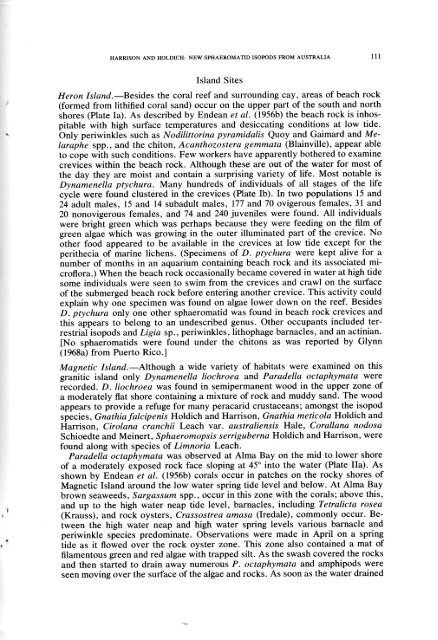Download PDF as one large file
Download PDF as one large file
Download PDF as one large file
Create successful ePaper yourself
Turn your PDF publications into a flip-book with our unique Google optimized e-Paper software.
HARMSON AND HOLDICH: NEW SPHAEROMATID ISOPODS FROM AUSTRALIA 111<br />
Island Sites<br />
Heron Island.—Besides the coral reef and surrounding cay, are<strong>as</strong> of beach rock<br />
(formed from lithified coral sand) occur on the upper part of the south and north<br />
shores (Plate la). As described by Endean et al. (1956b) the beach rock is inhospitable<br />
with high surface temperatures and desiccating conditions at low tide.<br />
Only periwinkles such <strong>as</strong> Nodilittorina pyramidalis Quoy and Gaimard and Melaraphe<br />
spp., and the chiton, Acanthozostera gemmata (Blainville), appear able<br />
to cope with such conditions. Few workers have apparently bothered to examine<br />
crevices within the beach rock. Although these are out of the water for most of<br />
the day they are moist and contain a surprising variety of life. Most notable is<br />
Dynamenella ptychura. Many hundreds of individuals of all stages of the life<br />
cycle were found clustered in the crevices (Plate lb). In two populations 15 and<br />
24 adult males, 15 and 14 subadult males, 177 and 70 ovigerous females, 31 and<br />
20 nonovigerous females, and 74 and 240 juveniles were found. All individuals<br />
were bright green which w<strong>as</strong> perhaps because they were feeding on the film of<br />
green algae which w<strong>as</strong> growing in the outer illuminated part of the crevice. No<br />
other food appeared to be available in the crevices at low tide except for the<br />
perithecia of marine lichens. (Specimens of D. ptychura were kept alive for a<br />
number of months in an aquarium containing beach rock and its <strong>as</strong>sociated microflora.)<br />
When the beach rock occ<strong>as</strong>ionaUy became covered in water at high tide<br />
some individuals were seen to swim from the crevices and crawl on the surface<br />
of the submerged beach rock before entering another crevice. This activity could<br />
explain why <strong>one</strong> specimen w<strong>as</strong> found on algae lower down on the reef. Besides<br />
D. ptychura only <strong>one</strong> other sphaeromatid w<strong>as</strong> found in beach rock crevices and<br />
this appears to belong to an undescribed genus. Other occupants included terrestrial<br />
isopods and Ligia sp., periwinkles, lithophage barnacles, and an actinian.<br />
[No sphaeromatids were found under the chitons <strong>as</strong> w<strong>as</strong> reported by Glynn<br />
(1968a) from Puerto Rico.]<br />
Magnetic Island.—Although a wide variety of habitats were examined on this<br />
granitic island only Dynamenella liochroea and Paradella octaphymata were<br />
recorded. D. liochroea w<strong>as</strong> found in semipermanent wood in the upper z<strong>one</strong> of<br />
a moderately flat shore containing a mixture of rock and muddy sand. The wood<br />
appears to provide a refuge for many peracarid crustaceans; amongst the isopod<br />
species, Gnathia falcipenis Holdich and Harrison, Gnathia meticola Holdich and<br />
Harrison, Cirolana cranchii Leach var. australiensis Hale, Corallana nodosa<br />
Schioedte and Meinert, Sphaeromopsis serriguberna Holdich and Harrison, were<br />
found along with species of Limnoria Leach.<br />
Paradella octaphymata w<strong>as</strong> observed at Alma Bay on the mid to lower shore<br />
of a moderately exposed rock face sloping at 45° into the water (Plate Ila). As<br />
shown by Endean et al. (1956b) corals occur in patches on the rocky shores of<br />
Magnetic Island around the low water spring tide level and below. At Alma Bay<br />
brown seaweeds, Sarg<strong>as</strong>sum spp., occur in this z<strong>one</strong> with the corals; above this,<br />
and up to the high water neap tide level, barnacles, including Tetralicta rosea<br />
(Krauss), and rock oysters, Cr<strong>as</strong>sostrea am<strong>as</strong>a (Iredale), commonly occur. Between<br />
the high water neap and high water spring levels various barnacle and<br />
periwinkle species predominate. Observations were made in April on a spring<br />
tide <strong>as</strong> it flowed over the rock oyster z<strong>one</strong>. This z<strong>one</strong> also contained a mat of<br />
filamentous green and red algae with trapped silt. As the sw<strong>as</strong>h covered the rocks<br />
and then started to drain away numerous P. octaphymata and amphipods were<br />
seen moving over the surface of the algae and rocks. As soon <strong>as</strong> the water drained

















